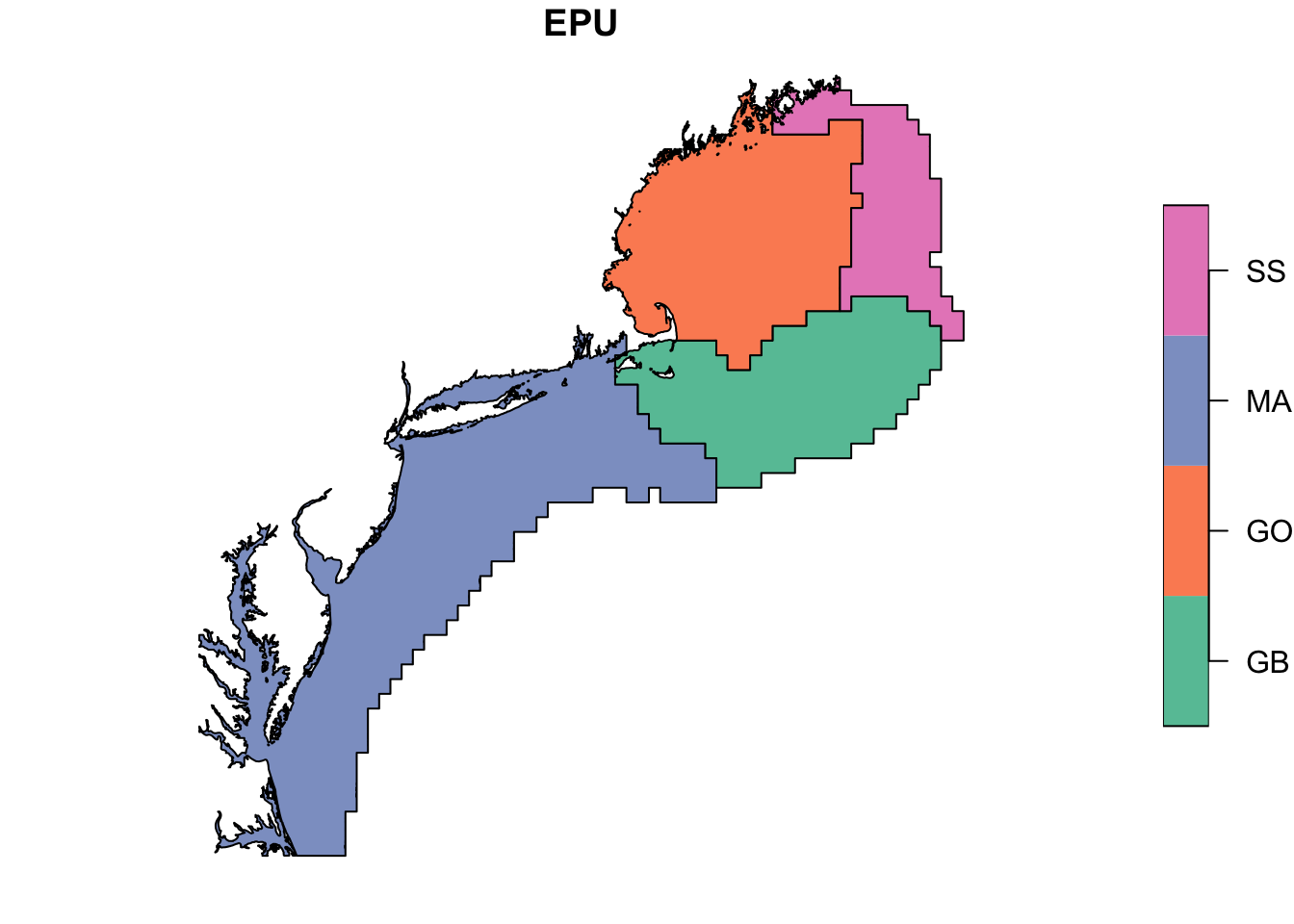3 Map
Learning Objectives
- TBD
3.1 Read Spatial Data
Open your r3-exercises.Rproj to launch RStudio into that project and set the working directory.
Create a new Rmarkdown file (RStudio menu File > New file > Rmarkdown…) called map.Rmd. Insert headers like last time followed by Chunks of R code according to the examples provided below.
I’ll be copy/pasting during the demonstration but I encourage you to type out the text to enhance understanding.
3.1.1 Install packages
# require() is like library() except returns FALSE if missing (vs error)
if (!require(librarian)){
install.packages("librarian")
library(librarian)
}
# librarian::shelf() is like library() except installs package if missing,
# even from Github if include owner/repo
shelf(
NOAA-EDAB/ecodata,
sf)
# librarian before version 1.8.1, got error:
# download from 'https://api.github.com/repos/NOAA-EDAB/ecodata/tarball/HEAD' failed3.2 Get spatial data
ecodata::epu_sf## Simple feature collection with 4 features and 3 fields
## Geometry type: MULTIPOLYGON
## Dimension: XY
## Bounding box: xmin: -77 ymin: 35.8327 xmax: -65.66667 ymax: 44.66667
## Geodetic CRS: NAD83
## EPU Shape_Leng Shape_Area geometry
## 0 GB 16.33086 6.162033 MULTIPOLYGON (((-66.5 42.16...
## 1 GOM 32.20684 7.545063 MULTIPOLYGON (((-69.26278 4...
## 2 SS 20.52712 3.350430 MULTIPOLYGON (((-67.54 44.6...
## 3 MAB 83.38407 15.695390 MULTIPOLYGON (((-75.97418 3...epu_sf <- ecodata::epu_sf %>%
st_transform(4326)So we see a geometry list column.
class(epu_sf)## [1] "sf" "data.frame"# "sf" "data.frame"
g1 <- epu_sf$geometry[1]
# see in Environment pane, expand g1plot(epu_sf)
plot(epu_sf["EPU"]) Where in the world is this?
Where in the world is this?
shelf(mapview)
mapview(epu_sf)shelf(leaflet)
leaflet() %>%
#addTiles() %>%
addProviderTiles(providers$Esri.OceanBasemap) %>%
addPolygons(data = epu_sf)3.3 Group by
sf is “tidy”
3.4 Extract from erddap
CoastWatch ERDDAP: search for “SST”:
shelf(
here,
rerddap)
sst_gd_rds <- here("data/sst_gd.rds")
epu_bb <- st_bbox(epu_sf)
epu_bb## xmin ymin xmax ymax
## -77.00000 35.83270 -65.66667 44.66667sst_info <- info('jplMURSST41mday')
sst_info## <ERDDAP info> jplMURSST41mday
## Base URL: https://upwell.pfeg.noaa.gov/erddap/
## Dataset Type: griddap
## Dimensions (range):
## time: (2002-06-16T00:00:00Z, 2021-06-16T00:00:00Z)
## latitude: (-89.99, 89.99)
## longitude: (-179.99, 180.0)
## Variables:
## mask:
## nobs:
## sst:
## Units: degree_Cif (!file.exists(sst_gd_rds)){
sst_gd <- griddap(
sst_info,
fields = "sst",
time = c("2020-06-16", "2021-06-16"),
longitude = epu_bb[c("xmin", "xmax")],
latitude = epu_bb[c("ymin", "ymax")])
saveRDS(sst_gd, file = sst_gd_rds)
}
sst_gd <- readRDS(sst_gd_rds)
sst_gd## <ERDDAP griddap> jplMURSST41mday
## Path: [~/Library/Caches/R/rerddap/6d0dbbf4f950f8dc4ffca5dd9b2cf661.nc]
## Last updated: [2021-07-12 17:47:17]
## File size: [52.2 mb]
## Dimensions (dims/vars): [3 X 1]
## Dim names: time, latitude, longitude
## Variable names: Sea Surface Temperature Monthly Mean
## data.frame (rows/columns): [13046670 X 4]
## # A tibble: 13,046,670 × 4
## time lat lon sst
## <chr> <dbl> <dbl> <dbl>
## 1 2020-06-16T00:00:00Z 35.8 -77 NA
## 2 2020-06-16T00:00:00Z 35.8 -77.0 NA
## 3 2020-06-16T00:00:00Z 35.8 -77.0 NA
## 4 2020-06-16T00:00:00Z 35.8 -77.0 NA
## 5 2020-06-16T00:00:00Z 35.8 -77.0 NA
## 6 2020-06-16T00:00:00Z 35.8 -76.9 NA
## 7 2020-06-16T00:00:00Z 35.8 -76.9 NA
## 8 2020-06-16T00:00:00Z 35.8 -76.9 NA
## 9 2020-06-16T00:00:00Z 35.8 -76.9 NA
## 10 2020-06-16T00:00:00Z 35.8 -76.9 NA
## # … with 13,046,660 more rowsnames(sst_gd)## [1] "summary" "data"shelf(
dplyr,
ggplot2,
mapdata)
# coastline
coast <- map_data(
"worldHires",
xlim = epu_bb[c("xmin", "xmax")],
ylim = epu_bb[c("ymin", "ymax")],
lforce = "e")
sst_df_last <- sst_gd$data %>%
filter(time == max(time))
# summary(sst_last)
ggplot(
data = sst_df_last,
aes(x = lon, y = lat, fill = sst)) +
geom_polygon(
data = coast,
aes(x = long, y = lat, group = group), fill = "grey80") +
geom_tile() +
scale_fill_gradientn(
colors = rerddap::colors$temperature, na.value = NA) +
theme_bw() +
ylab("Latitude") +
xlab("Longitude") +
ggtitle("Latest SST")
shelf(
purrr,
raster,
sp,
tidyr)
select <- dplyr::select
sst_tbl <- tibble(sst_gd$data) %>%
mutate(
# round b/c of uneven intervals
# unique(sst_gd$data$lon) %>% sort() %>% diff() %>% table()
# 0.0099945068359375 0.0100021362304688
lon = round(lon, 2),
lat = round(lat, 2),
date = as.Date(time, "%Y-%m-%dT00:00:00Z")) %>%
select(-time) %>%
filter(!is.na(sst)) # 13M to 8.8M rows
sst_tbl_mo <- sst_tbl %>%
nest(data = c(lat, lon, sst)) %>%
mutate(
raster = purrr::map(data, function(x) {
#browser()
sp::coordinates(x) <- ~ lon + lat
sp::gridded(x) <- T
raster::raster(x)
}))
sst_stk <- raster::stack(sst_tbl_mo$raster)
names(sst_stk) <- strftime(sst_tbl_mo$date, "sst_%Y.%m")
raster::crs(sst_stk) <- 4326shelf(stringr)
epu_sst_avg <- raster::extract(sst_stk, epu_sf, fun = mean, na.rm = T)
epu_sst_sd <- raster::extract(sst_stk, epu_sf, fun = sd, na.rm = T)
epu_sst_tbl <- rbind(
epu_sst_avg %>%
as_tibble() %>%
cbind(
EPU = epu_sf$EPU,
stat = "mean") %>%
pivot_longer(-c(EPU, stat)),
epu_sst_sd %>%
as_tibble() %>%
cbind(
EPU = epu_sf$EPU,
stat = "sd") %>%
pivot_longer(-c(EPU, stat))) %>%
mutate(
EPU = as.character(EPU),
date = as.double(str_replace(name, "sst_", ""))) %>%
select(-name) %>%
pivot_wider(
names_from = EPU,
values_from = value)shelf(dygraphs)
epu_sst_tbl %>%
filter(stat == "mean") %>%
select(-stat) %>%
dygraph()